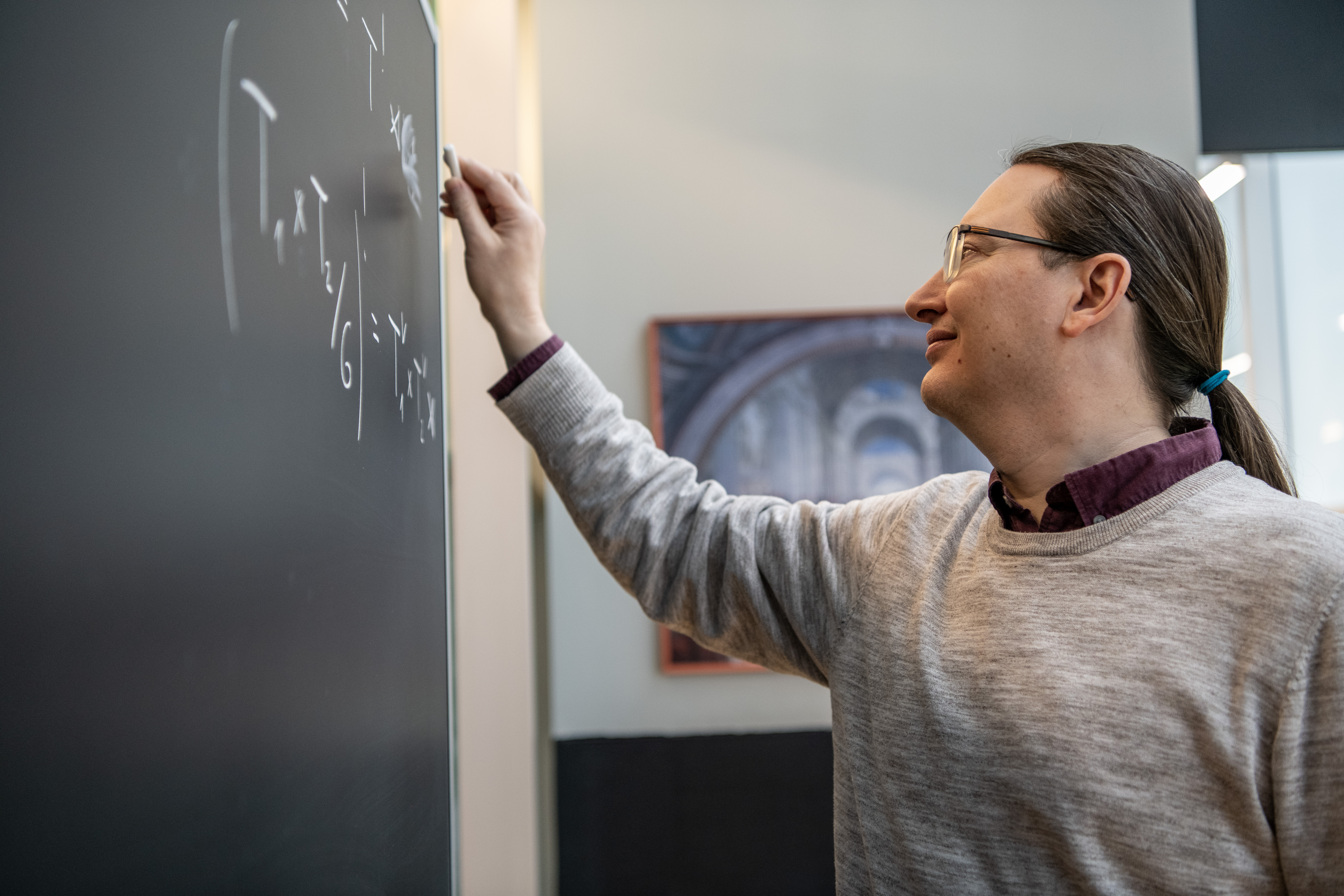In 1609, when Galileo Galilei tilted a handmade telescope toward the heavens, he also tilted the course of human thought.
Galileo observed four moons orbiting Jupiter — evidence that not everything revolves around Earth. That simple act of looking outward, farther than anyone had before, launched modern physics.
Four centuries later, Davide Gaiotto is focusing a lens — made not of glass, but of mathematics — on the cosmos. Through this perspective, Gaiotto observes a quantum cosmos thrumming with symmetries and fields, brimming with mysteries.
Gaiotto holds the Krembil Galileo Galilei Chair at Perimeter Institute, where he is pioneering new mathematical tools and models for deciphering the nature of spacetime.
“I like solving problems,” Gaiotto says without hesitation when asked why he became a theoretical physicist. “I like finding interesting problems. That’s what I do most of the time.”
The problems Gaiotto tackles are among the most complex in theoretical physics, which makes them among the most vexing in all of science.
Gaiotto’s passion for problem solving has set him on a path to reshape the scaffolding on which quantum field theory (QFT) and string theory stand. If Galileo gave us new eyes to see the heavens, Gaiotto is giving us new tools to see the hidden structures that underlie all of reality.
Gaiotto joined Perimeter after a postdoctoral term at the Institute for Advanced Study, where he collaborated closely with Ed Witten, one of the most influential figures in modern theoretical physics. Their joint work, on topics including the boundary conditions in supersymmetric gauge theories, helped shape several key developments at the intersection of quantum field theory and string theory.
When Gaiotto learned he would receive a named research chair at Perimeter, supported by the Krembil Foundation, he knew immediately who the chair should be named after.
“I picked Galileo. He was one of the first figures that changed the way we looked at the universe. Mathematics was the correct language to think about the universe.”
Like Galileo, Gaiotto believes even the most mathematically elegant explorations must be grounded in the right tools. Galileo gazed through a telescope; Gaiotto immerses himself in the mathematical machinery of quantum fields and strings.
“I study the tools we use to do theoretical physics, including quantum field theory and string theory,” he explains.
He’s not the kind of physicist who smashes particles in a lab; he’s figuring out the frameworks and models scientists use to describe reality.
One of Gaiotto’s most influential insights is a theoretical tool called the AGT correspondence – a kind of bridge that connects seemingly unrelated mathematical worlds: two-dimensional conformal field theories and four-dimensional supersymmetric gauge theories.
Imagine struggling to solve a complex puzzle in four dimensions, and then realizing that a simpler two-dimensional version contains all the same information – like discovering that a shadow on a wall tells you everything about the object casting it.
Gaiotto’s AGT work suggests deep, hidden symmetries that unify seemingly disparate aspects of the universe.
Gaiotto also helped redefine how physicists think about symmetry, one of the guiding principles in modern physics. With collaborators, he introduced the notion of higher-form symmetries, which apply not just to particles (zero-dimensional objects), but to extended entities like strings and membranes.
“I’m in a bit of a weird place between physics and math,” he admits. “Because I really care about the tools, even more than what you do with the tools themselves.”
His experiments happen on paper, or in computer code, or on the many blackboards around Perimeter, where Gaiotto can often be found collaborating with colleagues from different subdisciplines.
The brilliance of his ideas has not gone unnoticed by the research community. Gaiotto has earned a Gribov Medal, a New Horizons in Physics Prize, and most recently, a 2025 Frontiers of Science Award for his work on generalized symmetries.
He doesn’t talk about such accolades. He’s much more interested in talking about fundamental science – as much as possible.
“At PI, we can talk across boundaries much more freely (than anywhere else),” he says. “It fits in many corners and connects them.”
About PI
Perimeter Institute is the world’s largest research hub devoted to theoretical physics. The independent Institute was founded in 1999 to foster breakthroughs in the fundamental understanding of our universe, from the smallest particles to the entire cosmos. Research at Perimeter is motivated by the understanding that fundamental science advances human knowledge and catalyzes innovation, and that today’s theoretical physics is tomorrow’s technology. Located in the Region of Waterloo, the not-for-profit Institute is a unique public-private endeavour, including the Governments of Ontario and Canada, that enables cutting-edge research, trains the next generation of scientific pioneers, and shares the power of physics through award-winning educational outreach and public engagement.
You might be interested in



